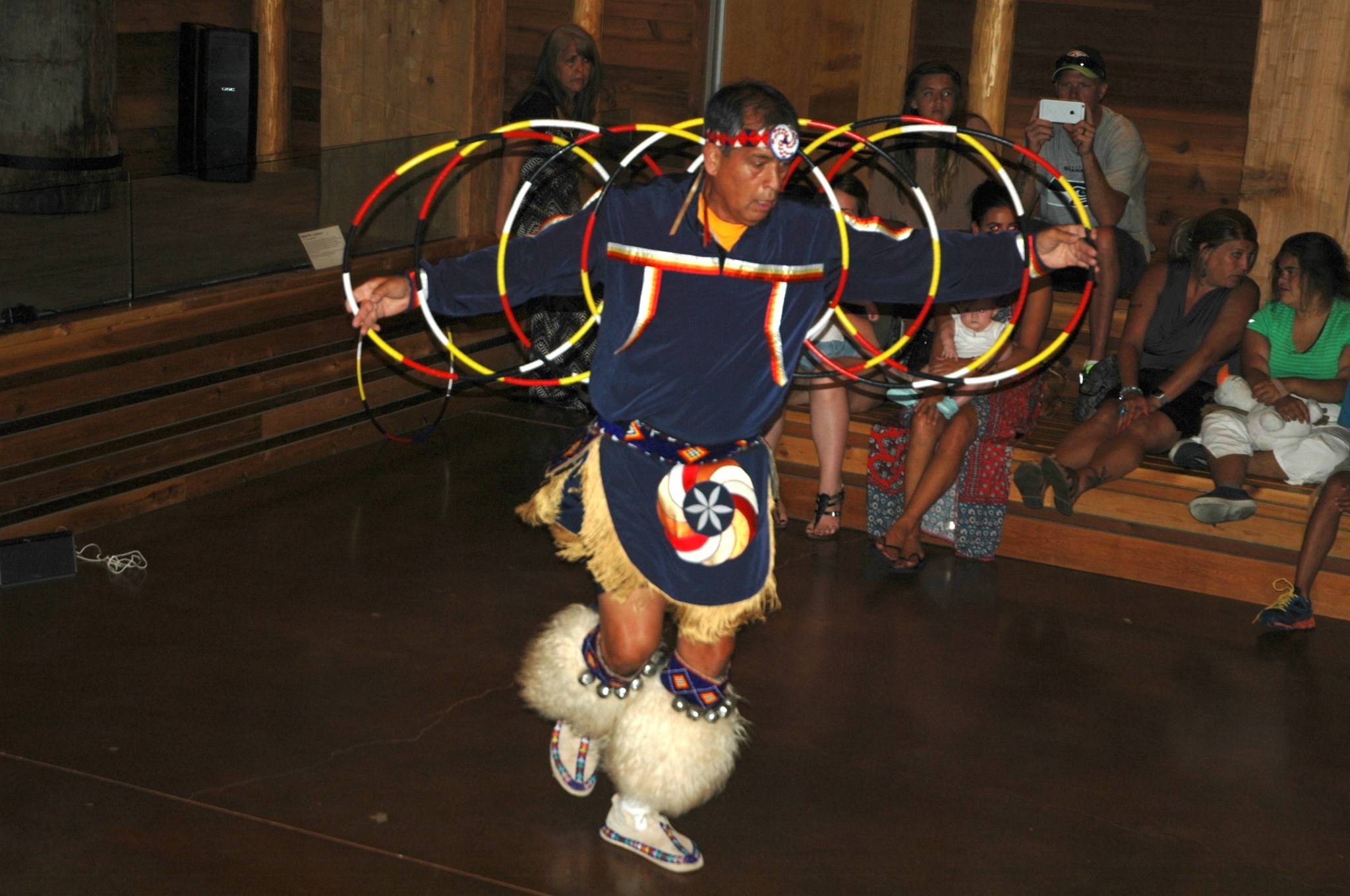TULALIP — The Hibulb Cultural Center celebrated its fifth anniversary of sharing the heritage of the Tulalip Tribes Aug. 20 with the help of Tulalip carver and storyteller Kelly Moses, as well as father-and-son hoop dancers Terry and Michael Goedel.
Moses opened by noting how sacred the cedar tree is to his people, since it served as raw material for longhouses, canoes, baskets and even clothes.
To illustrate the nature of cedar as a giving tree, Moses recounted a traditional tale of a little bird with a broken wing, who asked alder, cottonwood and maple trees if he could rest in their limbs. While those three trees turned the bird away, the cedar accepted him.
That did not go unnoticed by “the great changer, who sets the way things are,” who told the other trees that their leaves would turn brown and fall off for half the year, but told the cedar that its leaves would stay green all year long.
“You have to uphold your people,” said Moses, who praised the staff of Hibulb for carrying the legacy of the Tribes forward, “so our children don’t forget.”
Cedar, children and birds continued to play prominent roles in Moses’ other tales. He recounted a bird stopped an elk from bullying other animals — even after the bear, cougar and wolves had failed — by flying up the elk’s nose and taking its breath away.
Not only did Moses relate that to the bullying many children experience today, he also touted it as an example of how no one should be underestimated, a theme he also featured in his tale of a little girl who was trained to weave baskets by the cedar tree.Although the girl was quiet and slow, by repeatedly weaving and taking apart the same cedar basket, she finally learned how to weave a water-tight basket, a skill she shared with the rest of her people.
“Our ancestors used water-tight cedar baskets to cook and store their food,” Moses said. “Each one of us has a purpose. Even those of us who are overlooked carry a special gift within us.”
Meanwhile, Terry Goedel spent much of his early years not knowing his purpose. With a father who served in the Navy, his family moved around the country frequently, and it wasn’t until he turned 13 that he even realized he was Native American, when he finally moved back to the Tulalip reservation.
“This place introduced me to myself,” Goedel said. “I didn’t feel like I belonged here or in the outside world.”
It wasn’t until Goedel took his mother’s advice, and went to see tribal hoop dancers in 1971, that he found his connection to his heritage.
“I’d seen powwow dancers before, but the way these dancers spun and twirled their hoops captivated me,” Goedel said. “Forty-five years ago, I realized it was wonderful to be Native American, and I wanted to share that with the world.”
Goedel’s 23-year-old son, Michael, has been dancing with him for a dozen years. Michael explained that their dance would be the story of a young bird, growing and developing, learning through experience to become capable on its own.
The Goedels explained the symbolism of the hoops themselves. Four hoops are used to represent the four directions — north, south, east and west — as are their colors — red, yellow, black and white — which represent all the peoples of the world.
“We add a fifth hoop to represent the great creator spirit,” Michael said. “That hoop is in the middle, because that spirit holds the world together. We need the great spirit if we want to get along.”
“Each one of us has our own story to share,” said Goedel, who pointed out that both his daughters are hoop dancers as well, an opportunity that might not have been afforded to them in the past. “I’m no better or worse than anyone else, but my story is unique. You have to find your light, so you can share it with the world.”
Michael credited hoop dancing with drawing him out of his shell as an 11-year-old.
“When I was a little boy, I was really quiet and never asked questions,” Michael said. “I found it hard to express myself in words, but when I learned to dance, I could express myself through song and dance. It even helped me start to speak. If what you’ve seen here has touched you, then help the world becomes a better place.”
“It’s the most wonderful feeling when people ask me where I’m from, and I can tell them that I’m from Tulalip,” said Goedel, who praised Hibulb for “keeping the richness of who we are alive. This museum documents our genealogy and family histories, so we can know who we are, and who our families were.”



